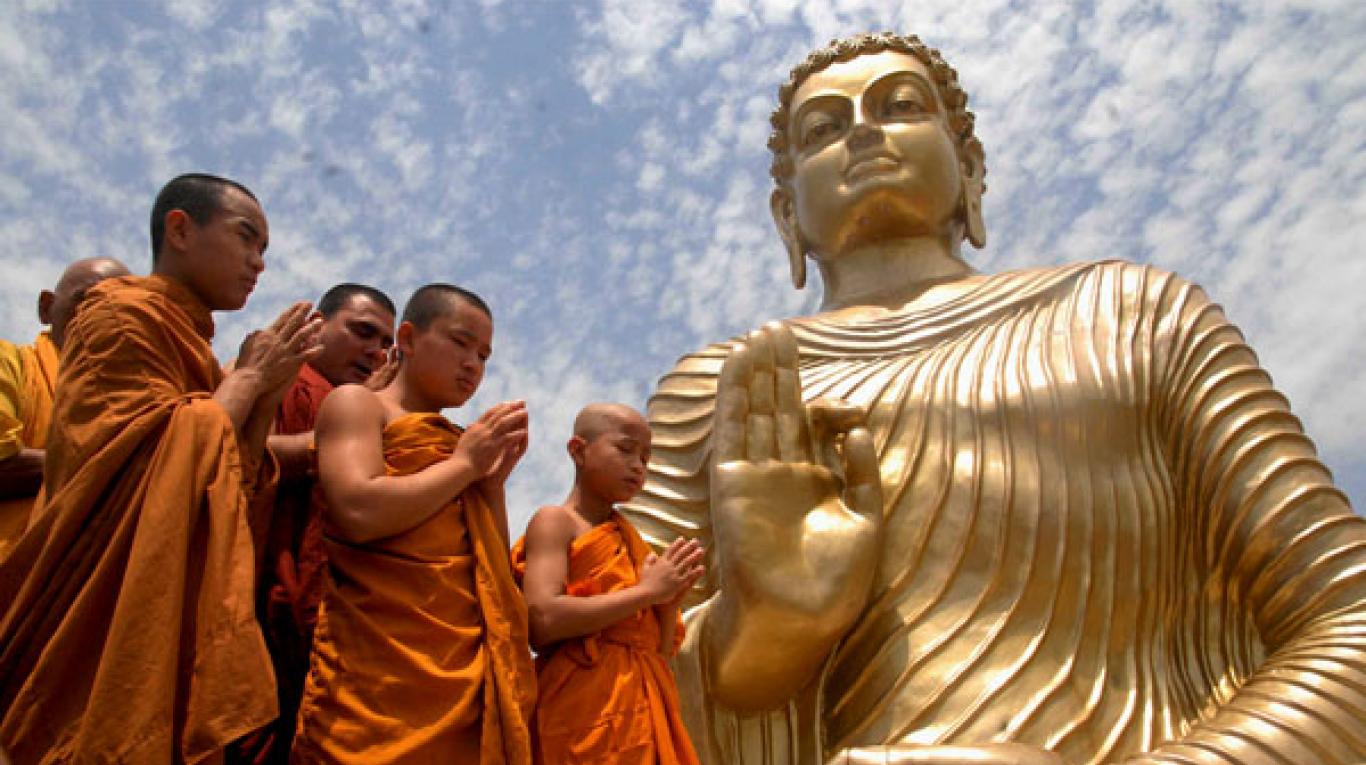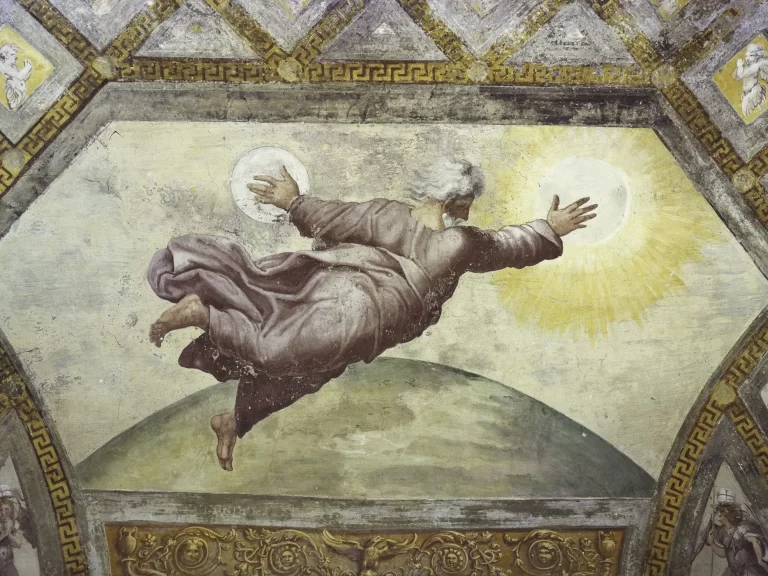History of the Doctrine of Buddhism and Meditation
The doctrine of Buddhism is much more than a religion, it is a set of ideas that leads the individual to free himself from feelings and thoughts of low vibration (hatred, greed, ignorance, among others), which allows the individual to take advantage of his life to the fullest and perceive pain and life from a different perspective.
Origin of Buddhism
The doctrine of Buddhism was born in India, around the 6th and 4th centuries BC. From there it spread rapidly to East Asia and became the predominant religion in India in the 3rd century BC.
During this century, Emperor Asoka (India) transformed the doctrine of Buddhism into the official religion of his empire, however, in the 7th century its practice declined in an amazing way during the Middle Ages, being a religion almost extinct in India, although spread throughout the Asian continent.
The word “Buddha is Sanskrit”, comes from the root “Bud”, which means both “awakening” and “knowing” or “enlightenment”. The Buddha then is “the awakened one”, “the wise one” and “the enlightened one”.
History
The doctrine of Buddhism is a path that includes a series of Buddhist practices such as meditation or experience developed within the Buddhist tradition, which, over thousands of years, have been transformed into a path for those who wish to follow a path of development. spiritual.
Buddhism comes from Buddha and the translation from Sanskrit is “awakening”. The doctrine of Buddhism is a philosophical-religious system that developed in the East, first in India, and then in China, Japan, Tibet, among other countries in the Far East.
Not only did its institutions evolve, but so did its doctrine, generating numerous schools, and some of them took as a principle certain postulates by the Buddha himself, the first Gautama Buddha.
Buddhism, like few religions, offers a more or less defined goal for man, it offers an entrance that leads to the goal, however, it does not speak of the path.
The knowledge of this path is in a certain way exclusive to walkers, for a very simple reason: the description of the path can disturb the entry into it, the “entrance to the stream”, as the Buddhists themselves call it.
The goal of Buddhism is Nirvana, perfection, eternal health, eternal joy, the ultimate reality, the ultrasensory world, the union of the individual with the universe, but what makes Buddhism different from other religions is that (in a principle) affirmed that man could reach an eternal divine state, when most religions promise a “paradise” to those who act in a good way, and would only reach this state after abandoning their life on this plane, on the other life.
In other words, the doctrine of Buddhism has always affirmed the possibility of achieving an evolution of man, from a spiritual and psychic sense. Buddhism preached and still insists that man can become a divine being.
Few religions are so generous to man, in fact, they impose a moral code and encourage nothing more than worship. Buddhism whispers a grow, while the others, only obey.
Buddhism is not atheist, nor is it completely a philosophy, although many of its schools can be considered “atheistic”, simply because there are no demands for obedience to a God or a saint, or a single divine man.
They are completely theistic or monotheistic, when it comes to attaining God or Nirvana. The school of faith Buddhism is a school that today still uses the worship of the Buddhas and bodhisattvas as the axis of its doctrine and as a means of achieving the faith that leads to entrance.
The doctrine of Buddhism cannot be classified as a philosophical system either, simply because it does not teach anything that is not useful for the salvation of man. Anything that goes beyond the scope of man’s salvation must be omitted because it can disturb the search for the entrance or Nirvana.
A religion with philosophical and psychological components of an extraordinary pragmatism, and perhaps also, of a powerful efficiency and of an honesty without limits, towards its essence.
Buddhism as a religion was always consistent with its doctrine, preached pacifism, tolerance, friendship, non-violence, and never came to impose its doctrine or convert the infidels by force.
The doctrine itself affirmed that Buddhism could not be attained by everyone, which did not prevent Buddhas and monks from making efforts to expand the opportunities of access to the Buddhist paths.
He did not fight against polytheistic Hindu paganism, or wanted to eliminate it, on the contrary, he took various elements from it to incorporate it into his doctrine. The result is the warmth and pacifism of the men of the Far East, who in pre-Buddhic times were strongly inclined to sacrifices and cruelties.
All these characteristics make Buddhism the oldest religion and institution, which even today, all the beautiful, but mundane attractions that our times require, remains in force.
The doctrine of Buddhism shares the same beginning with Christianity, the rejection of a world of suffering, temptation or sin, a withdrawal from the world, in this sense, both religions share the same “beginning”.
In its origins, important cinemite and ascetic movements were generated, the spirit seekers abandon the world and retire in the solitude of the forests or walk long distances with the only sustenance of begging.
A short time later, also, in both religions, some enlightened, awakened, holy ones begin to preach, schools are set up and small monasteries are built. The cinemites are grouped, disciples are received, and then the doctrines are written.
It is at this stage where the great differences between Christianity and Buddhism appear. Differences in structure, hierarchy, doctrine and actions.
The doctrine of Buddhism is expanding rapidly, generating protestant and protestant schools, while Christianity remains tenaciously linked to the institution of the Catholic faith.
Myths and Facts
There are various myths and facts about Buddhism, therefore, in this article we will clarify each of them. The intention is to be a little clearer about the “path” that he preaches in order to follow it.
Buddhism is a peaceful doctrine; unlike other religions, never used violence?
This is totally false. Buddhism suffered various and unjust persecutions as well. For example, Chinese Buddhists enforced the doctrine of Buddhism “by crook,” that is, they executed Confucian and Taoist priests, in at least six different periods throughout that nation’s history.
Buddhist monks, thanks to being excellent state commissioners, found it easy to influence the kings of Thailand, Burma and Korea. Also, they managed to influence the Japanese war captains or “shogun” with the doctrine of Buddhism, declaring Buddhism as the official religion and eradicating any other belief.
Wars crueler than any other kind of combat took place in Japan between:
- Buddhists of Kyoto and Nara (8th century).
- The Shingon sect and the Tendai sect (10th century)
- The Nirichen and Zen (13th century)
As we can see, and if we take a historical perspective, the doctrine of Buddhism is not far behind in imposing itself as a religion by force, as did Christianity, Islam or Judaism.
In Buddhism is the god Buddha worshiped?
It’s false. As we mentioned before, Buddhism does not worship a single God, although certainly one of the best known Buddhist figures in the West is, without a doubt, Siddhartha Gautama. A prince of India who lived in the V century BC and marked the beginning of this religion.
However, he is not worshiped as a god, but rather, revered as a teacher who expressed in a certain way how human life goes? Who considers himself a follower of Buddhism does not seek to demonstrate his love for Buddha, but to be a Buddha or “enlightened”. There are a diverse number of Buddhas, and anyone can be one if he puts his mind to it.
Buddhism, unlike other religions, does not seek to gain followers?
Once again, this myth is false, since one of the activities proposed by Buddhism is its missionary activity. An example of this is that there are various “sects” such as the Nirichen have established missionary centers in different countries such as California or Hawaii. Obviously, these are financed by recognized companies and artists, otherwise this task would be impossible.
Now, we will share some myths that are taught in Buddhism. These are more akin to a “story” than a verifiable fact or not. We could say that they are metaphors, that seek to give us a message, however, we think it is important to share them.
Some myths and fables of Buddhism
Something positive that we can rescue from myths is that they allow us to develop great imaginative potential. Let us then see some myths of Buddhism:
The flower that announces the bonanza
The story tells that there is a flower that is capable of blooming anywhere, its stem is finer than a hair and its very particular color: pearly white. Beyond these fascinating and unique characteristics, there are people who say that it takes up to three thousand years for it to bloom, therefore, finding this beautiful and rare flower represents bonanza and prosperity for all.
It is important to be like this rare flower. Being authentic and flourishing anywhere, or in other words, knowing how to adapt to different circumstances. We are unique, wonderful and we can always shine with our own light.
Another message that we can highlight from this story is to give ourselves time, for what? For all! Grow, learn, mature. Everything has stages, let’s not seek to go faster, but enjoy the journey.
It’s not a flower, it’s an egg
It’s quite interesting. He tells us that what they thought was a flower, thanks to the discovery of a scientist, they realized that it was nothing more than the laying of an insect, to which their eggs remained attached.
The first thing, science, will always try to explain scientifically what it does not understand. For a doctor, it is very difficult to believe in miracles, for example, for these, if there is no fact that proves it, it does not exist, but faith goes far beyond reason and human understanding.
Second, the fact of how to believe in something can have a different perspective or meaning. The question is not what to believe, but to do it with faith. Perhaps, magic and miracles do not exist for those who do not believe, but in the same way, for those who believe in miracles or magic, wonderful things can result and be witnesses.
The Crane and the Crab
This fable tells the story of a crane, a sea of fish and a crab. At the beginning, the crane convinces the fish through tricks, showing them a supposed lagoon where it would take them because humans would “dry up the seas” and it would not bear to see them die en masse. The deal was that he would eat only one or two factions occasionally to sate his hunger, but in return, he would save them all.
Then, he told the crab that he would start with him, to enter his beak and he would carry him. The crab, more cunning and cautious than the fish, told him that it would be better for both of them to go around his neck because his claws were stronger. The crane, believing that he would accomplish his task, agrees and flies away.
Arriving at the place of the supposed lagoon, the crab asked him, and where is the lagoon that you promised? To which the crane replies that it was nothing more than a trick to eat him first, and then the others. The crab, neither stupid nor lazy, stuck its pincers in the neck of the crane and it fell dead.
The message? Whoever acts with bad intentions gets shot in the butt.
The Wise Fairies and the Foolish Fairies
It is said that when the fairies of the woods came to earth they separated into two groups. The prudent ones stayed together in the immensity and tranquility of the forest, but the foolish ones decided to go to the fields where the man lived, because according to them, these would fill them with gifts.
One day, one of the men, in the middle of a fit of fury, uprooted the trees that were around him, trees, where the foolish fairies lived, which were left alone and homeless.
The fairies who had decided to stay together in the depths of the forest despite the storms, remained united and calm, nothing more than a few shakes and that’s it. This shows that sometimes we foolishly listen to wise words, and in that search for independence and wanting to be recognized and idolized, we end up lost and with nothing.
In the union there is strength, the saying goes, and as we see, it is not in vain. We will always need others, so let’s not be self-centered and express our need to want to be free or give in to our impulse desires. Let’s do what suits us and learn to listen to our conscience.
The most powerful being in the world
It tells the story of a powerful wizard who, seeing an owl fly with a little mouse in its beak, decided to take the mouse and transform it into a beautiful princess, who, of course, had a mission: to get a husband.
The young, ambitious and thirsty for power asked the powerful magician to offer his hand, and he did so. They started with the sun, then with the cloud, then with the wind, but all of them answered the same “there is one more powerful than me”.
To the surprise of the now young woman and the magician, the most powerful being was “the mountain mouse”, how was this possible? Well, it turns out that there was no wind, sun, storm or circumstance that the little mouse could not overcome.
From this fable we can extract two messages, the first, that we are what we are because that is how it should be and although we do not perceive it, we are powerful in that way. The second, that no matter who we want to be or how powerful we aspire to be, our essence will always remain intact.
Buddhism Doctrine
The doctrine of Buddhism tolerates new ideas, as long as the search for spirit is stimulated. Contrary to Catholicism, which represses any attempt at independence that does not come from its institution.
Both seduce Reyes, both are welcomed, the general features of their evolution suggest the same origin, but if we look at their structures in detail, we will see great differences.
Buddhism is not generated in a single “sacred book”, it offers dozens of books considered “sacred”, and without one that has stood out too much. The same goes for “holy” men.
The first Saint Gautama is considered one among many “saints”, without any preference or favoritism. Some works are dedicated especially to discipline, others to meditation and concentration exercises, still others to psychological schematization, to the words spoken by the Buddha, to trance, to emptiness, to magical practices, to morality and to the ethics, to cosmogony.
There is such a wealth of Buddhist works that are sinful of being extensive, transforming the doctrine of Buddhism into a labyrinth, but nevertheless, they offer such a variety of concepts, that if we compare Buddhists with the Christian scriptures, we would see a child next to a teacher.
The different Buddhist works have a chronological order, which suggests a kind of “path” of fifteen hundred (1500) years. A path in stages of a great river that receives various sources and that widens, perhaps making it more difficult to cross to the other shore.
Doctrinal orthodoxy interceded for the liberation of the customs that founded Buddhism. The stream, the albeo is today called “Hinayana”: Sanskrit word meaning “lesser vehicle”.
The widened tributaries were grouped under the name of Mahāyāna: a Sanskrit word that means “major vehicle” and represents one of the branches of Buddhism.
Essentially, we can say that the closest truth we have is suffering. The dukkha of suffering or dukkha dukkhata is what we can all consider as suffering, that is, a headache, a toothache, we go through great pain in our lives, among others.
Also, we have the suffering of change, which is when we become attached to someone or something, but still lose it. And finally, we have all-pervasive suffering, or all-encompassing suffering, which refers to that discomfort that is always there, yet very subtle, so we continually avoid it.
So, I recognize my lack and then I insist on “getting it” and with this I am distracted, and while I am distracted, I do not experience that suffering.
This then becomes a vicious circle that never ends, where, I admit, I get distracted, I don’t suffer and I feel that emptiness again, that lack and start again from scratch.
We could then say that the second noble truth is Krishna and all its forms, it is the cause of the first, therefore, it is the ignorance of our true condition and we can also find it in deep meditative states, and it only dissolves in states of contemplation in the afterlife.
Then, a third type is perceiving in terms of concept and feeling that each thing is what it really is, for example, you are you, I am me, among others. This makes us experience and understand that we are faced with suffering, of suffering, of the suffering of change.
That is, when I reject an object, then I am rejecting all my experience, and if we reject a physical situation, then we experience it as “pain”. That is why, on many occasions, we experience a kind of emotional roller coaster, and we go from “I’m fine” to I’m bad, from pleasure to pain, and so on.
We can define a fourth type, to give it some sense of “classification”, in which we feel that we have been living throughout our lives in the wrong way, then we start looking for a new way and we feel that this new way is the true way. to “connect with reality”.
The third truth then is Nirvana, which in a way is the feeling of “suffering”, but also the feeling of all mental activity. However, in Mahāyāna the third truth is considered to be awakening, which is that state beyond all sense of separateness and external worlds.
With all this we are not only explaining a little what is buddhahood? And also, what is the buddha? Not only as a historical buddha, but as the “state of buddha”, that is, “everyone” can achieve it.
There are Buddhist books that explain that we all have a Buddhahood, but we are not aware of it. Our buddhahood is always there, it is like the sun, only covered by clouds, and therefore, we do not perceive it.
There is another example, which is a bit contrary to this one and which tells us that our Buddhahood is total, it is rather like a seed, which requires watering and care in order to emerge. Perhaps this makes a little more sense to some, but Buddhism has multiple paths to reach it and all have their truth and reason for being.
So how can we simply explain the “state of buddha”? We can see it as the total lack of the first and second truth, that is, if there is no cause there is no effect, and if there is no effect, then we do not experience the “suffering”, much less the suffering, of suffering, so that there is also no state of self-interference (self-sabotage).
In short, the four doctrines by which Buddhism is governed are:
- Life is full of suffering.
- The cause of suffering is desire.
- Extinguishing desire makes suffering cease.
- To extinguish desire and its consequent suffering, one must follow the Eightfold Path, what does this mean? Vision, life, aspirations, effort, conscience, conduct and concentration “correct”.
The human being has developed a project to dominate nature, where we do not seem to be fully aware that we are destroying ourselves, but why is this happening? Because we feel intrinsically separated from nature and from other human beings.
It is almost as if we see ourselves as opposed to other human beings, so we feel the need to dominate them in order to adapt them to us and use them as a resource for our own benefit.
We also have a fragmentary consciousness, where according to our own beliefs we will perceive the ecosystem differently, of which, ironically, we are also a part.
At the same time, all this chaos is what would make us fall into consciousness and want to recover everything that we once destroyed. Perhaps, it sounds a bit strange, but this is the degree of psychosis in which we find ourselves today.
The samsara or cycle of reincarnations includes six types of existence, among them we can mention: in hell, as an animal, as a tortured spirit, as an asura or evil spirit and as a human or as a deva or benign god.
It is important to note that being a god does not imply an improvement in the situation, nor would we get rid of all this psychosis, since we would be more limited by not knowing how to be human beings? And this would be a bigger challenge.
When as human beings we decide to embark on the path of Buddhism, our goal is to achieve in this or the next life the desired “enlightenment”, and of course, the certainty of the four truths mentioned above, so that by leaving this physical plane we reach extinction or nirvana, and we overcome the desire and suffering experienced in it.
Another way to see the Eightfold Path is to remove all the stimuli that activate our passions, why? Because our passions generate problems, suffering, and even make us fall into acts that can generate bad karmas.
Getting away from these stimuli can also give us that peace of mind, that at given times we can apply practices that allow us to discover our true condition, but, unfortunately, it is not the most direct way, because if they tell us “do not think of a monkey”, ¿ what am I going to think about? In the monkey! That is our human nature.
Buddhas y bodhisattvas
This story begins with Siddhartha Gautama (558-478 BC). and a prophecy that announced that a newborn would be the emperor of the entire universe, therefore, a king decided to surround his son with all the luxury and comfort that existed in the world, however, one day, he became curious to know the world and there was no one who could make him change his mind.
His father, the king, then ordered that all signs of pain or suffering be eliminated, but this could not prevent his son from seeing with his own eyes the marked old age in an old man, or people suffering due to illness, or a day, he came across a dead body.
His vision changed radically when he came across an ascetic who claimed that his life was full despite the fact that he begged for food. From that day on, he abandoned his kingdom and his family and decided to live an ascetic life. When he was about to die from not trying any food, he understood that this was not the way to achieve such “happiness” either.
Practices
The primary practice of the doctrine of Buddhism is the “way.” This path is a kind of “commandments”, which come from the demands of the eightfold path:
- Right View: Believing, understanding, and practicing the Four Noble Truths.
- Correct aspirations: Do not be greedy, do not covet and do not have anger.
- Correct words: Do not lie, do not speak in vain, do not insult.
- Correct conduct: Do not kill, do not steal, do not adulterate (basis of “non-violence”).
- Correct life: Do not do anything timid or shameful.
- Right Effort: Devote yourself entirely to the right ends.
- Right Awareness: Achieving Peace of Mind; and peace of mind.
- Correct concentration: Obtain wisdom.
These factors are not isolated, on the other hand, so they must be developed simultaneously. Actually, each one is related to and contributes to the cultivation of the others.
The objective or intention of these principles is to develop each one of them until obtaining the total perfection of the three main principles that profess the Buddhist training and discipline: Wisdom (pa” la), ethical conduct (sila) and mental discipline. (samadhi).
Wisdom implies right or correct understanding and thoughts, that is, Understanding of the four Noble Truths, causality and impermanence. On the other hand, right thinking implies thinking from detachment and in a loving way.
Also, it is renunciation and non-violence, of course, with wisdom. Avoid at all times thoughts of malevolence, attachments of all kinds, violence or hatred, as a way to avoid “ignorance”.
The correct and ethical Conduct implies then, the use of correct words, but also the application of these by means of correct means of life.
Ethical conduct (sila) is based on the broad conception of universal love and compassion towards all living beings. These are central to the Buddha’s teaching.
What does the Right Word refer to? Refrain from speaking negligently, profanity, slander or slander to harm others. It is rather, cultivate and use friendly, sweet, meaningful, useful, pleasant words that generate good for others.
A right action aspiration is to constantly profess and practice moral, honorable and peaceful behaviors and not from anger, lack of control or dishonesty. It also implies not stealing, killing or having illegitimate sexual relations.
The Right Means of life, as its words indicate, is to earn a living in an honest and irreproachable way, avoiding any profession or trade that could harm other living beings.
Mental discipline refers mainly to a right concentration, attention and effort in everything we do.
Right Effort, what does it imply? Mainly, four efforts:
- Discourage bad thoughts from disturbing us or taking over us.
- In case of having “bad” thoughts in our mind, abandon them immediately, in this way we will take away their power.
- Cultivate “good” or positive thoughts.
- Try as much as possible to keep these “good” thoughts in our minds, until they become almost a habit. And of course, cultivate the Dhamma or teachings with special attention.
Right attention involves four states of mental attention:
- Paying the due attention that our body requires is our temple and we must take care of it.
- Pay special attention to our sensations and emotions. Learn to recognize them.
- Meditate on what activities our mind generates? And don’t take it lightly.
- Pay important attention to our ideas, beliefs, thoughts, concepts and things, what are they? What has led me to believe this way? (dharma).
Right Concentration is that discipline that will lead us to the four stages of dhyana, or absorption. In the first stage, we abandon our thoughts and desires born of passion or considered “impure”.
In the second stage, once the various mental activities are gone, we can develop peace and tranquility of mind, a “unifying fixation of the mind.”
In the third stage, conscious equanimity is born and in the fourth stage we can feel how all those negative sensations disappear and disappear, all those emotions that generate sorrow, discomfort, misery, and allow us to remain in a state of mental clarity.
This Noble Eightfold Path can be followed, practiced and developed by each individual. It is bodily, verbal and mental discipline. It is a Path that leads to the apprehension of the ultimate Reality, to the achievement of liberation, happiness and peace, through moral, spiritual and intellectual self-development.
Common rituals in Buddhism are very few, those that stand out as “most important” we can mention:
- Entry into the Brotherhood
- The celebrations in commemoration of the birth (April 8) and enlightenment (December 8) of Sakyamuni (Budha).
- The two weeks of Higan (one celebrated in spring and the other in autumn) in which the Brotherhood perseveres in the development of said discipline.
By accepting the existence of gods (but not the most important thing), Buddhism in each region takes as its own some rituals or myths given in the past, and adapts them to its doctrine.
To preserve the remains of Sakyamuni, “stupas” were built in different parts of India, that is, circular temples without any human form (or at least it was originally like that) and they represented Buddha as a linden tree, a wheel of eight lightning or a flame, and this was the “way”. Today, many temples have up to a thousand “idols.”
Some of the practices that are carried out in these temples are: meditation or daily prayers, veneration of images, songs, burning of incense, and mantras.
The monks of the different temples complemented these practices with activities such as: martial arts, yoga, sound meditation, gardening, mandalas, celibacy, studies, painting, isolation, among others.
Who was Buddha?
His real name was Sidrarta Gautama, an ascetic and wise man. He founder of what we know today as the doctrine of Buddhism .
There is no formal writing that gives the exact date of his birth, however, experts suppose that it was around the year 600-400 BC in Lumbitu, before, this was known as “India”, now, it would be a region of Nepal.
He was the son of kings, so his life was very ostentatious, opulent and aristocratic, and he was always separated from the real world, and was surrounded by luxuries. In fact, he married a princess quite young, with whom he had a son.
He did not know sickness, suffering or old age, because he lived in a world of fantasy. However, one day he met an ascetic who marked a before and after in his life, because he had a life of peace and calm and it seemed curious to him how someone could achieve this life of “no suffering”.
Living what could be his first real experience, he decides to abandon his opulent life, his family and his kingdom and dedicated himself to learning from all kinds of “masters” and then getting his truth.
So he kept learning and meditating for years, until one day he decided to make a vow with the sole purpose of meditating until he reached the “truth” and what was the key to life? It is said that he remained in this meditative state for seven weeks and that when he awoke he had become “enlightened” and knew the way to attain that life of peace.
This event occurred when he was thirty-five years old and since then he has become a Buddha. He was a Hindu, so he believed in reincarnation, and what he professed was that this cycle of incarnation had to be broken, since it is what finally leads the human being to suffer pain due to “past karmas”.
He decided to dedicate the rest of his life to teaching the Four Nobles, practicing paramita, and teaching the Eightfold Path, a series of steps to attain “enlightenment.”
One day, Buddha experienced a sweet agony and surrounded by his most faithful disciples, reached nirvana at the age of eighty, in northern India, in Kusinagara. It is said that Sakyamuni (as he was known) had six other existences and in each of them, he managed to attain enlightenment.
Over the years there have been a variety of Buddhas with a common goal: not to reach nirvana until they have helped others to achieve it first.
Nirvana de Siddhartha
Siddhartha underwent various stages of meditation, including extreme practices such as not eating, but this only managed to almost take his life. Once he understood that this was not the way he began to meditate nonstop and went through three stages.
In the first stage, he became aware of his previous existences, this is known in Buddhism as pubbe nivasanussati ñana .
In the second meditative stage, he acquired the knowledge of seeing beings die and be reborn again according to the nature of the actions that he has had throughout his life. This is what is known as cutupapata ñana in Buddhism.
The third and last stage, perhaps the hardest of them, was the one in which he purified his mind (asavakkhaya ñana) and had a clear understanding of the Four Noble Truths (cattari ariya-saccani) in order to achieve that life of “no suffering” and happiness.
One last test that he had to face was the temptations of Mara (a demon), getting rid of any passion that could generate suffering or actions that he could regret.
Finally, he reached the state of no return or nirvana, resting then for all eternity and breaking the chain of reincarnation; The moment of his awakening was the starting point that gave rise to what we know today as the doctrine of Buddhism .
Buddhist fundamentals
The foundations of Buddha is the reason why he stands out as a spiritual teacher, is that he left as a legacy a series of foundations contained and extracted from the eightfold path, which allow anyone who follows them to reach that state of enlightenment, enjoy a life of no suffering and a peace that goes beyond death (nirvana).
Buddhism Concepts
We can explain these “concepts” in a simple way by dividing them between: the three characteristics of existence, karma, what is its cause and effect? what is the functionality of karma? The rebirth, nirvana and the four truths, which we have already mentioned above.
The Three Characteristics of Existence (Tri-Laksana)
Its translation from Sanskrit could mean: the three marks, like the three seals, or also, the three realities, any one is valid. This teaching is fundamental in Buddhism, since it explains how the world is perceived? What are those universal characteristics?
We can summarize it in three characteristics:
- Anitya: It refers to impermanence, transience or change.
- Anātman: Refers to insubstantiality and permanently rejects the ego.
- Duḥkha: It refers to suffering, to those sensations that generate discontent or great dissatisfaction. A little what the four truths also speak.
Karma: cause and effect
In Sanskrit we can translate it as “Causality”. But also as: an intentional and premeditated action. Seed. The law of cause and effect. Conditioning.
According to Buddhism, every intentional action generates karma, and in turn, creates one or multiple effects or consequences that appear when certain circumstances are “attracted”, so to speak. These “consequences” are called “ripening” (vipaka) or fruit (phala).
Karma applied to the doctrine of Buddhism refers to any action whether it is speech, thought or from the body itself. Therefore, as occurs with a reflex action, although these may be neutral karmically speaking, they generate karma, even when they are not generated consciously.
Perhaps, you have heard of “good karma” and “bad karma”, but how are they different? Simple, based on the root or intentions of our actions.
In the Kukkuravatika Sutta , the great teacher Buddha classifies karma into four distinct groups:
- Dark with dark result.
- Brilliant with brilliant result.
- Dark and shiny with a dark and shiny result.
- Neither dark nor bright with a result that is neither dark nor bright.
But what does all this dark or bright mean? Good. Darkness or evil (however you want to see it), can’t generate light or shine, can it? Let’s see it with an example: a life full of negative thoughts cannot lead us to achieve a full and happy life.
However, karma does not necessarily have to be positive or negative at all, it can be mixed, since we could have had good actions or intentions and others not so good, do you understand?
Karma in the doctrine of Buddhism explains a little why some people live a long life of wealth, beauty and happiness and others live a life of lack, need and misery.
In the Cula-kammavibhanga Sutta , the Buddha explains that none of this is by chance, but consequences of karma.
So what is karma? Let’s say that it is a kind of law that judges us whether we have committed “good” or “bad” actions consciously or unconsciously.
In the text Mahakammavibhanga Sutta, Buddha explains to us extensively, what are the four types of people that we can distinguish according to their karma? and what are their predictable destinies based on his karma?
- Who does evil and goes to a hell, state of degeneration or a lower rebirth.
- Who does evil and goes to a higher heaven, happy state or rebirth.
- Who does good and goes to a higher heaven, happy state or rebirth.
- Who does good and goes to a hell, state of degeneracy or a lower rebirth.
With this, we can notice how “heaven” or “hell” are expressed not as something that we will experience after death, but rather, as cycles of happiness or light or darkness and great misery and unhappiness during our lives as a consequence. of those previous actions generated from conscious or unconscious thoughts or intentions.
So, we can see karma as a reflection of reality, and although we do not always see it as “fair”, good or bad actions will not necessarily generate the effect we seek.
For example, if we give bread to a hungry man but with the intention of being recognized or seen as “kind”, then our action, although apparently good, turns out to be cloudy.
It is important to clarify and emphasize that the Buddhist karma doctrine has nothing to do with destiny or that everything is already written, since there is a will, therefore, it is not possible to anticipate what will happen, how it will develop or what way we will be judged by karma.
The different Buddhist practices allow us to observe ourselves in a more leisurely and conscious way. It is if you want a way to be able to prevent in a certain way behaviors that generate bad karma and distance ourselves from malicious tendencies.
Karma should not be seen as a punishment. If we don’t see our DNA this way, then why see it this way with karma? It is rather a kind of learning, a reminder that this time we must do things better and break the chain of reincarnations.
Karma , in fact, is one of the five types of conditionality or logical processes of the Universe, also known as niyamas:
- Inorganic.
- Organic.
- psychological.
- Moral.
- Transcendental.
These types of conditionality or processes of the universe are totally impersonal, that is, there is no type of divine intervention in them.
Some types of conditionality are immutable, meaning that not even a Buddha can escape being affected by it at least once, once he is born and has a body.
karma working
The role of karma is basically the consequence of our actions expressed under a consequence. This karma, of course, is purely individual. So, we could summarize it as follows:
- Samskara or predisposition.
- Karma or act.
- Vipakao fruit; bone, the result of our actions, now transformed into “experience”, which leads us to a new disposition or Samskara, and the cycle repeats itself.
The operation of karma is a very extensive and complex topic, so let’s see it simple: disposition, act and consequence. It does not always manifest itself immediately and we should not see it as “punishment”.
Conditioned arising (pratītya-samutpāda)
The conditioned arising is perfectly detailed in the Maha-nidana Sutta or “Discourse on Causes”, which allows us to understand how it is that we remain clinging to this circle of eternal suffering?
Of course, this process involves both our past actions and our current actions. This dependent origination includes 12 links:
- Avidyā : ignorance.
- Samskāra : mental formations.
- Vijñāna : consciousness.
- Nāma Rūpa : name and form (pre-materiality).
- ŞaDāyatana : sensoriality (sense organs).
- Sparsha : contacto.
- Vedanā : sensation.
- Tŗşņa : wish, want.
- ”Upādāna”: clinging.
- Bhava : devenir.
- Jāti : birth.
- Jarā-maraņa : decay, old age, death.
Each of these, starting with ignorance, leads to the next and so on, until reaching our death, so we can say that as long as ignorance is not eradicated, the circle will repeat itself over and over again, and the only way to break with this chain is reaching nirvana.
Renaissance
In the doctrine of Buddhism there is no talk of “reincarnation” but of “rebirth”, this is because they affirm that a soul cannot transmigrate from one body to another.
To better understand this concept it is important to first understand what is Anātman? It is a Sanskrit term that can be translated as “Absence or insubstantiality of a soul” or “Lack of an enduring ego (self) or lack of intrinsic existence”.
So, we can say that the Buddhist rebirth is rather a process or manifestation of karma accumulated through actions as conscious beings, but it does not arise or relate to the soul or the eternal spirit. These actions will bring us a series of consequences either in this life or in the next.
Rebirth is not seen as “desirable” for the doctrine of Buddhism , nor does it mean a marked destiny; The Buddhist path is then seen as the route for us to free ourselves from that series of circumstances, causes or effects that we generate through our actions.
Obviously, each of us must experience and face different situations, the issue is how do we face them? From love and do we perceive it as learning? Or from malice and we perceive it as punishment?
Meditation is a fundamental practice for Buddhism, since with it, the Buddhist learns and understands that he is not only the owner of his thoughts, but also responsible for them, and realizes how important it is to learn to control our thoughts, in turn, manage emotions, and in turn, this translates into more conscious actions.
Living from attachment or detachment is essential to obtain or achieve more of that state of mental peace, a better perception of oneself and the world in general.
Nirvāņa : The Awakening, The Enlightenment
Master Buddha affirms that through Buddhist practice it is totally possible to definitively break that cycle of dependency and rebirth. The goal is, therefore, to achieve the awakening of Samsāra in order to experience the immensity and true nature of existence and life.
Nirvāņa is essentially described by what it is not: not-born, not-created, not-originated, not-compounded and should not be confused with annihilation, isolation of the individual or nihilism (rejection of any religious or moral principle, said Nirvāņa). otherwise, it is the belief that life is meaningless).
The branches of Buddhism
Currently, there are various “branches” that profess the doctrine of Buddhism , however, they all come from the same source: the Buddha himself.
The dharmas embodied in the sacred texts or Sutras represent the essence of the various aspects of the Buddhist tradition , which are divided into three major branches:
Terevada
Represented as the oldest Buddhist school, whose teachings and doctrines we can see a strong presence in countries such as: Cambodia, Thailand, or Sri Lanka.
They involve their practitioners in both environmental and social programs and teach them about mindful meditation through breathing and bodily sensations that allow them to free themselves from all selfishness or unhappiness. Also, they teach about the sweetness of love and compassion.
Mahayana
It is a branch that has two peculiarities. First, they give their students complete freedom to question and test for themselves theories offered in the past. The second is that it has two aspects: Pure Earth and Zen.
Its dogma (irrefutable belief) is based on the Perfection of Wisdom and Lotus Sutras. The practice of it is strongest in countries like Japan, Korea, Taiwan, China, Tibet.
Vajrayana or Tantric
It is, if you want an extension of the Mahayana, the difference is that it incorporates esoteric techniques.
Work from consequence and transcendence, to finally reach understanding and express the great (unlimited) potential of our mind. His teachings are based on the Great Seal, known as the highest wisdoms offered by the Buddha.
His meditations are intended to assimilate the evil generated in our minds and transform it into “positive thoughts” of their own nature.
Principles of Buddhism
In the Benares sermon, the enlightened master Buddha left clear but fundamental instructions on the principle of Buddhism, these are: The Noble Truths and the Noble Eightfold Path, mentioned and explained above.
The purposes that Buddhist practitioners seek are: the improvement of discipline and mental ethics , conduct and wisdom.
Buddhist texts
Buddhism, like all Indian religions, was an oral tradition. The words of the Buddha, the doctrines, concepts of him, and even the interpretations of each of these were communicated from generation to generation and by word of mouth in the different monasteries and not through written texts as happened with Christianity or Islam.
In fact, the first discovered Buddhist texts were written in Sri Lanka, approximately 400 years after the death of the Buddha.
Most of its practitioners agree that the number of texts offered by Buddhism is quite extensive, and they are not subject to a single line of thought or path.
Also, freedom is given in some branches to question and verify for themselves many of these theories or beliefs, something that would be unthinkable for Christianity, for example.
There are more than 40,000 manuscripts discovered by the year 1900 in the Dunhuang cave (China). Most of these are Buddhist texts, however others are not; In Theravada Buddhism, the standard collection of sacred texts is the Pali Canon.
The Pāli Tipitaka, whose translation can be: “three baskets” and refers to the Vinaya Pitaka, the Sutta Pitaka and the Abhidhamma Pitaka. These represent the oldest complete canonical works in an ancient language of Buddhism.
The Vinaya Pitaka contains rigorous guidelines for Buddhist monasteries. On the other hand, the Sutta Pitaka contains words that have been attributed to Master Buddha.
And the Abhidhamma Pitaka includes both expositions and commentaries on the Sutta, and these vary between Buddhist schools, as each one has adapted it to their doctrine, beliefs, and practices.
criticism of Buddhism
After having read and understood all the advantages and freedoms that some branches of Buddhism offer, you are probably wondering what criticisms it can have?
Buddhism, like any other religion, has not been the exception for its practitioners to be criticized or persecuted. In addition to the imposition of force as a religion by some characters in history.
Most of the criticisms towards Buddhism come from agnostics, people who do not share or understand their beliefs, skeptics, anti-religious, in short, people who do not share their ideals or who affirm that these never existed and are nothing more than an invention of the men.
The reality is that it is this or any other religion that is practiced (or not), we all have the freedom to believe or not in what we want. The objective of any religion will be love and the ingredient that cannot be lacking is faith.
Something very positive that we can highlight about the doctrine of Buddhism is that it shows us that we are all human beings, and as such, we must learn to be respectful and tolerant of others.







